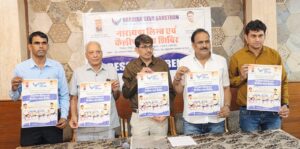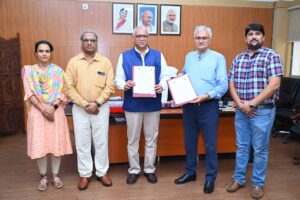
(By Medha Bajpai, psychological counselor and educationist)
For a while we were all left blank and bewildered, for the next 2 hours our group did not talk to anyone, we were not in a position to talk. I am talking about the Cellular Jail Andaman which was once a symbol of British oppression and today is a national memorial dedicated to the epic of India’s freedom struggle, every brick of which bears witness and there are stories on every wall.
I got an opportunity to visit Andaman and visit this pilgrimage with Prof. P. K. Purohit, Prof. C.C. Tripathi and Mrs. Vandana Tripathi in a national seminar. We visited this prison called Kalapani while continuously hearing about the freedom fighters and Veer Savarkar with Dr. C.C. Tripathi and Mrs. Vandana Tripathi.
Veer Savarkar ji had composed the epics ‘Kamala‘ and ‘Gomantak‘ in Kalapani. Going to his prison cell and paying obeisance to him felt as if I had offered a little bit of my patriotism. The guide said that tears of eyes and sea water, stories of heroes are very deep and people like to watch from a distance.
The location of the Cellular Jail, known as “Kala Paani” surrounded by the sea on the islands of Andaman, symbolized a mental and physical isolation for the prisoners. It is very important to go to a place which fills you with the feeling of patriotism, to pay homage to the martyrs and to pass on our heritage to the new generation. The structure of the jail and the conditions there tell the story of the martyrdom and struggle of these brave, countless unnamed revolutionaries.
According to scholars, the word “Andaman” is believed to be related to “Hanuman“. It is believed that this word entered Malay language from Sanskrit language and then became popular as “Andaman”.“After the First War of Independence in 1857, the British decided to occupy the islands and develop them as a colony to punish freedom fighters.
The British rule chose the Andaman Islands, considering them isolated islands from which no one could escape. The climate and harsh conditions of this place were another challenge for the prisoners. A major reason for this was the belief at that time that by crossing the sea the prisoners, who were mostly Brahmins and Kshatriyas, would lose their caste, which was very precious to every Indian. The inhospitable environment, the barbarity and the 1200 kilometer sea were enough to automatically put them in a natural prison.
The captive colony began with the arrival of the first batch of 200 freedom fighters of the First War of Independence in Andaman and Nicobar Islands on 10 March 1858. All were patriots sentenced to long and life imprisonment, who for some reason had escaped the death penalty in Burma and India, and were sent to the prison colony of Andaman.
To make the process of punishment more difficult, the construction of Cellular Jail started in 1896 and was completed in 1906. The construction work was also done by Indian laborers and political prisoners. How gruesome it must be to work at the thought of building a prison for oneself. They had to work in unbearable conditions, and many people died during construction.
A massive three-story structure, shaped like a starfish, with seven wings radiating from a central watchtower, the standard design of most British prisons, a prison that could hold up to 698 people in solitary confinement. Vinayak Damodar Savarkar, the freedom fighter who was sent to the Andamans in 1911 to serve a 50-year sentence, wrote his memoirs in Marathi, describing the tortures and punishments he faced as a political prisoner in the Cellular Jail.
There were extremely inhumane conditions for the prisoners in Cellular Jail. They were kept in chains, and locked in a small cell where there was lack of air and light. The prisoners were forced to perform hard physical labour, including extracting oil from coconut fiber, chopping wood, operating a crusher and performing various tasks. If they failed to do the work, they were whipped and hanged.
No prisoner was allowed to stay in any one cell for long so that no one could make a collective plan. And if caught, punishment and hanging was given publicly so that its effect would be on everyone. On some days, three prisoners were hanged together.
Even today, when I stand in front of the hanging house, the scenes of screams and torture come to my mind. I stood there for a long time in a daze. The period from 1933 to 1938 was the most difficult for this Kalapani Jail. In 1939, due to pressure from the countrymen, I had to empty it completely. The mental and emotional impact of this situation is beyond imagination.
On one hand, these fighters had put their families, society, and their lives at stake for the freedom of the country. But on the other hand, their struggle was not understood by some people of their own country, and they were at the hands of the British.
Seeing their friend in prison dying and breaking down every day, and then hearing the sounds of music and joy coming from Ross Island, must have been a deep blow to their mental balance. Ross Island (presently Netaji Subhash Chandra Bose Island) was called the “Paris of the East” by the British government. The grand buildings there, the beautiful gardens, the clubs, the churches, and the luxurious life of the officers were complete proof that they were living in a different and comfortable world. Here British officers lived with their families, partied, and drank alcohol.
For the British this place was a resting place, where he could celebrate all the joys of his life. But just two kilometers away from this life of luxury, Indian freedom fighters were facing unbearable torture for their country in the Cellular Jail. Perhaps the biggest torture for those freedom fighters was that they fought to free the country from the British, but in some parts of the country people were engaged in the service of the British, and were also complicit in the torture inflicted by them.
No matter how much the freedom fighters of Cellular Jail suffered mentally and physically, they never turned away from their cause. The story of his indomitable courage and struggle is still the foundation of our country’s independence. Salute to these martyrs.







